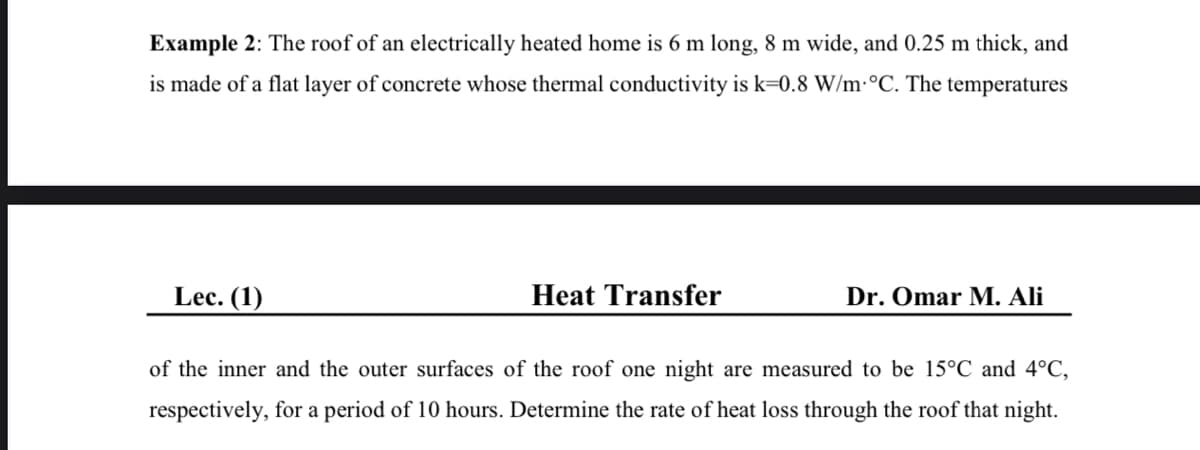Example 2: The roof of an electrically heated home is 6 m long, 8 m wide, and 0.25 m thick, and is made of a flat layer of concrete whose thermal conductivity is k=0.8 W/m·°C. The temperatures of the inner and the outer surfaces of the roof one night are measured to be 15°C and 4°C, respectively, for a period of 10 hours. Determine the rate of heat loss through the roof that night
Example 2: The roof of an electrically heated home is 6 m long, 8 m wide, and 0.25 m thick, and is made of a flat layer of concrete whose thermal conductivity is k=0.8 W/m·°C. The temperatures of the inner and the outer surfaces of the roof one night are measured to be 15°C and 4°C, respectively, for a period of 10 hours. Determine the rate of heat loss through the roof that night
Principles of Heat Transfer (Activate Learning with these NEW titles from Engineering!)
8th Edition
ISBN:9781305387102
Author:Kreith, Frank; Manglik, Raj M.
Publisher:Kreith, Frank; Manglik, Raj M.
Chapter1: Basic Modes Of Heat Transfer
Section: Chapter Questions
Problem 1.19P: 1.19 A cryogenic fluid is stored in a 0.3-m-diameter spherical container is still air. If the...
Related questions
Question
Example 2: The roof of an electrically heated home is 6 m long, 8 m wide, and 0.25 m thick, and is made of a flat layer of concrete whose thermal conductivity is k=0.8 W/m·°C. The temperatures of the inner and the outer surfaces of the roof one night are measured to be 15°C and 4°C, respectively, for a period of 10 hours. Determine the rate of heat loss through the roof that night

Transcribed Image Text:Example 2: The roof of an electrically heated home is 6 m long, 8 m wide, and 0.25 m thick, and
is made of a flat layer of concrete whose thermal conductivity is k=0.8 W/m·°C. The temperatures
Lec. (1)
Heat Transfer
Dr. Omar M. Ali
of the inner and the outer surfaces of the roof one night are measured to be 15°C and 4°C,
respectively, for a period of 10 hours. Determine the rate of heat loss through the roof that night.
Expert Solution
This question has been solved!
Explore an expertly crafted, step-by-step solution for a thorough understanding of key concepts.
This is a popular solution!
Trending now
This is a popular solution!
Step by step
Solved in 2 steps with 2 images

Knowledge Booster
Learn more about
Need a deep-dive on the concept behind this application? Look no further. Learn more about this topic, mechanical-engineering and related others by exploring similar questions and additional content below.Recommended textbooks for you

Principles of Heat Transfer (Activate Learning wi…
Mechanical Engineering
ISBN:
9781305387102
Author:
Kreith, Frank; Manglik, Raj M.
Publisher:
Cengage Learning

Principles of Heat Transfer (Activate Learning wi…
Mechanical Engineering
ISBN:
9781305387102
Author:
Kreith, Frank; Manglik, Raj M.
Publisher:
Cengage Learning